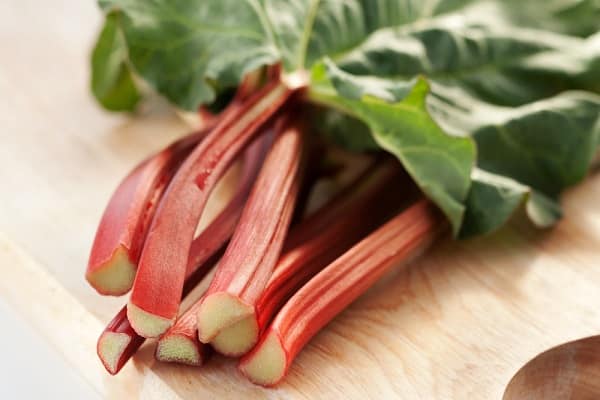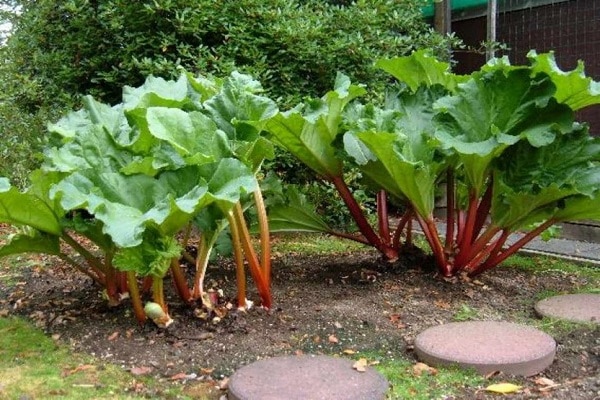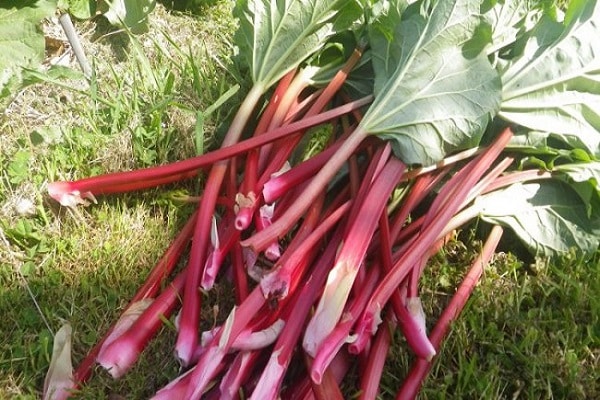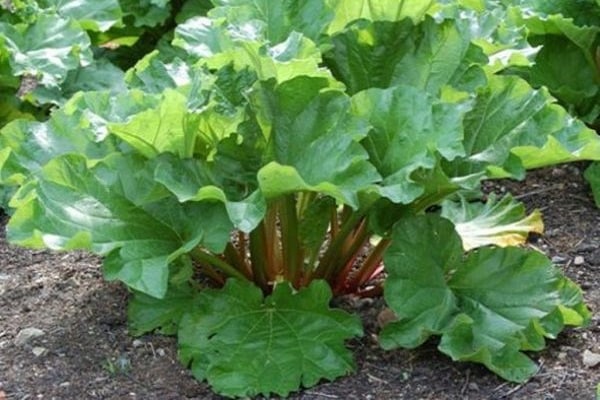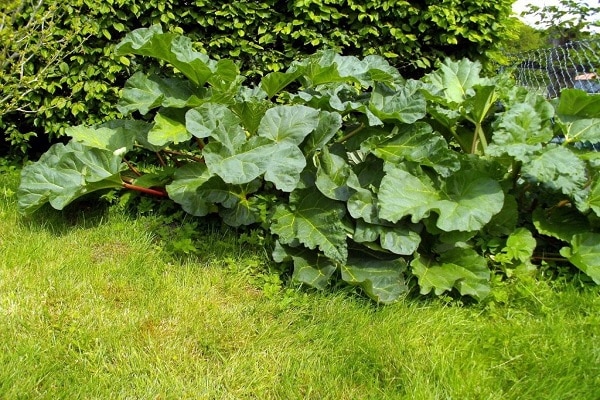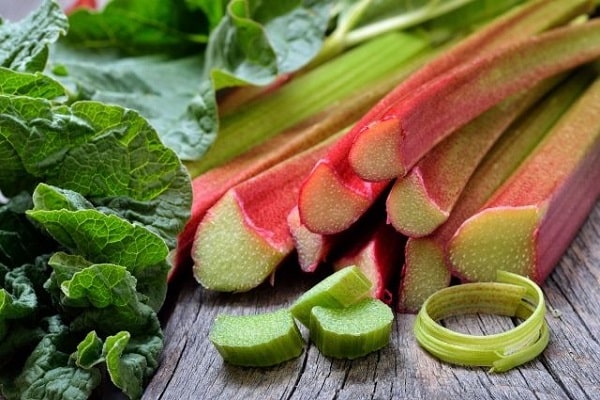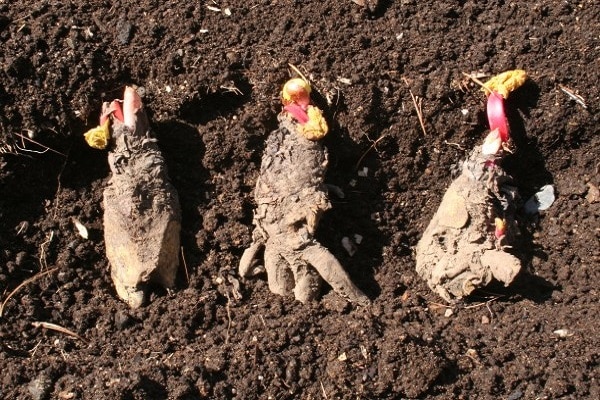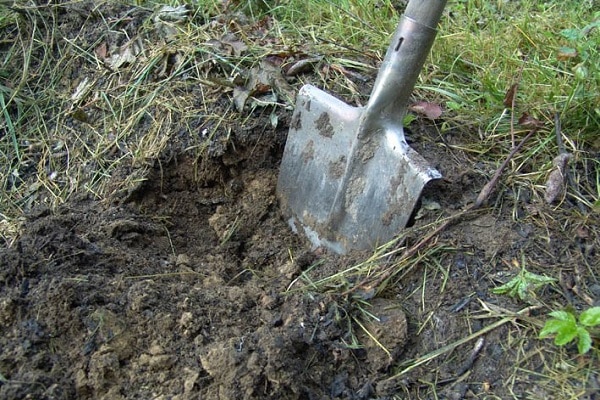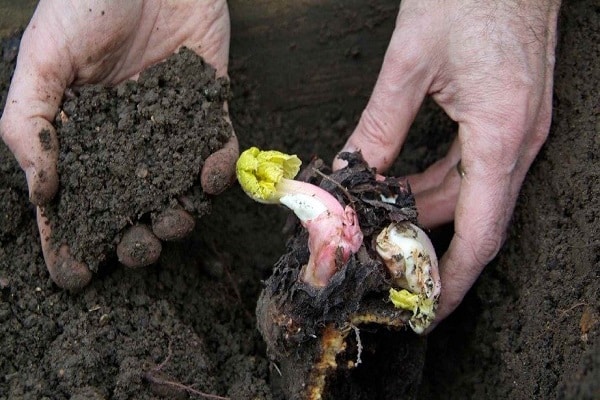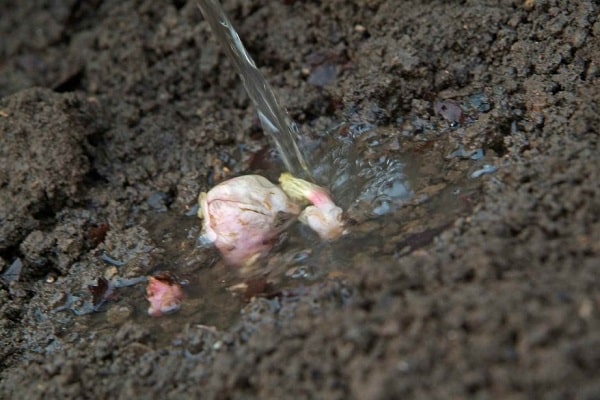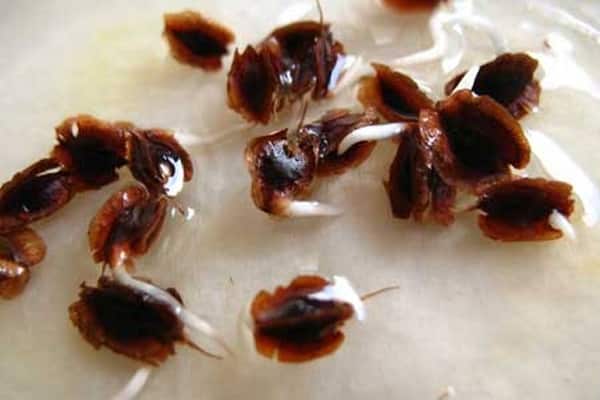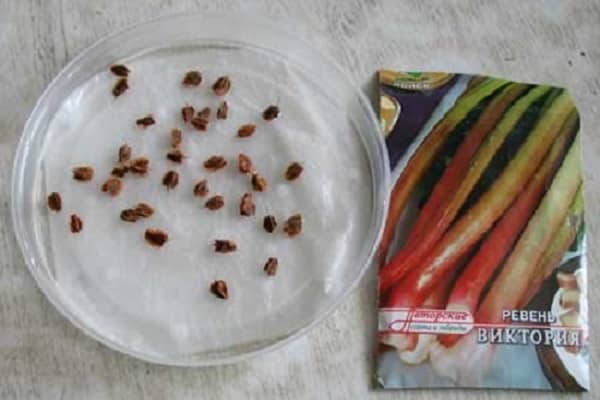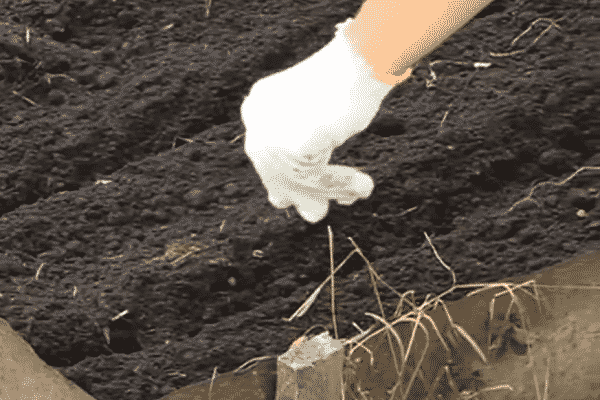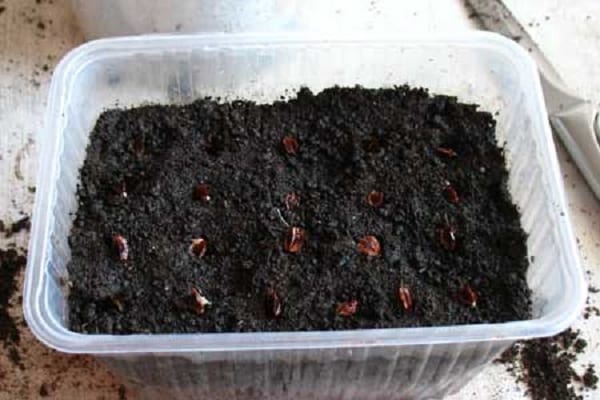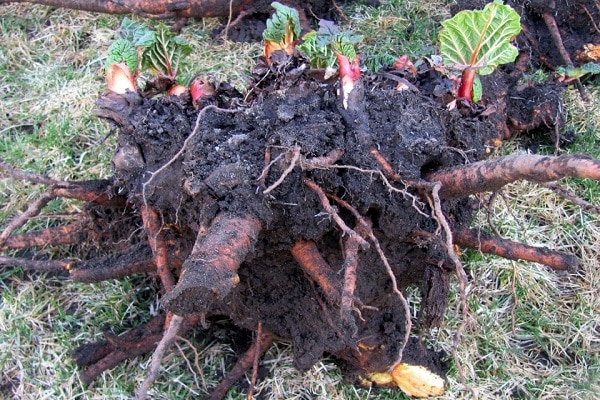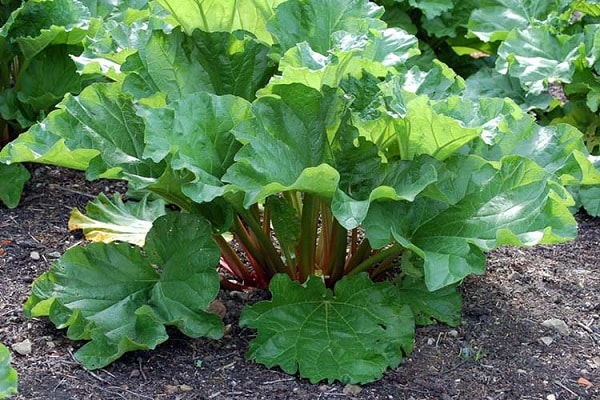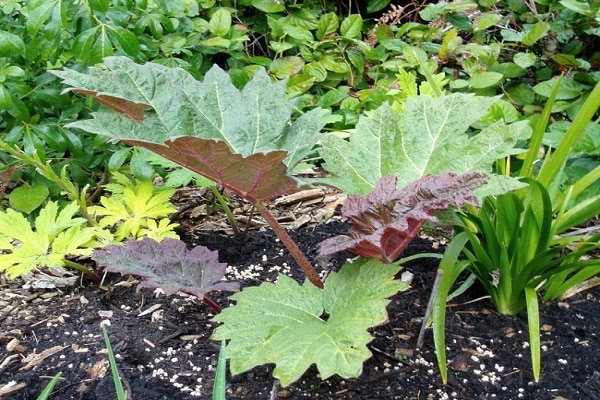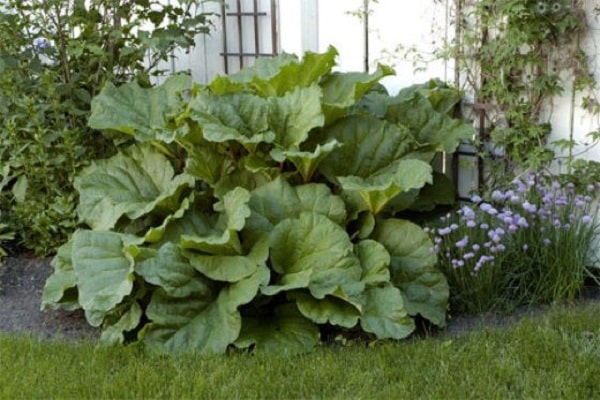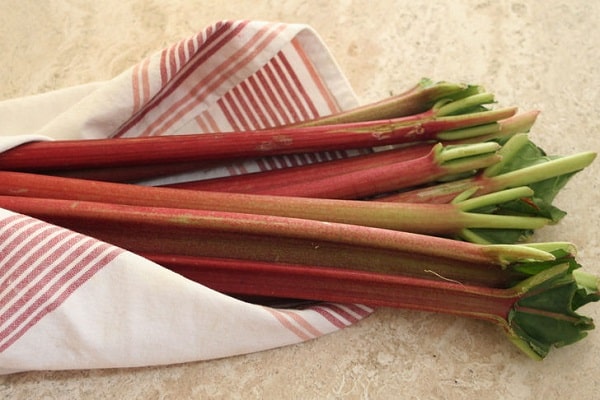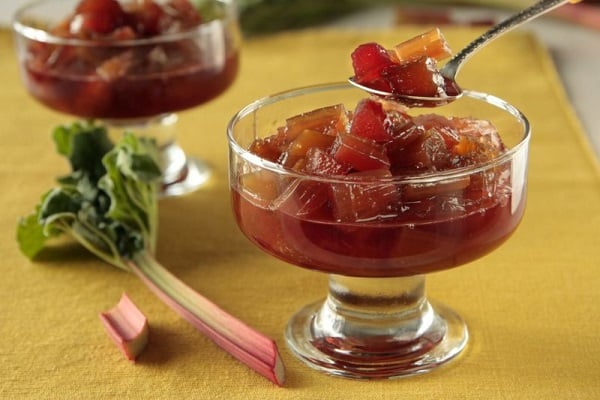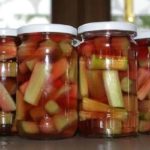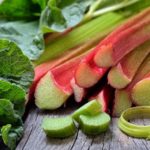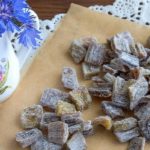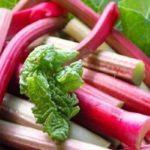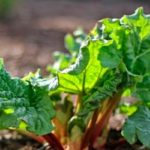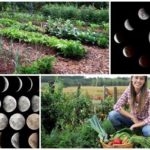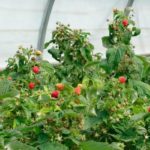One of the plants that can please you in early spring with a set of vitamins, pectin and organic acids is rhubarb. It is unpretentious, frost-resistant and, with the right approach, is capable of producing products from petioles almost all year round. The owner can pamper himself and his family with compotes, jelly, and salads when other vegetables in the garden are just beginning to sprout. And growing and caring for rhubarb will not require much cost or effort.
- Brief description of rhubarb
- Main varieties and varieties
- Combining rhubarb with other plants
- Planting time
- Planting with rhizomes
- Preparing for landing
- Rhizome division
- Planting options
- Planting rhubarb with seeds
- Preparing seeds for sowing
- Sowing in open ground
- Sowing seedlings
- Features of rhubarb transplantation depending on the season
- Rhubarb care
- Feeding and fertilizing the plant
- Watering and weeding
- Protection from diseases and pests
- Harvesting rules
Brief description of rhubarb
Rhubarb (Rheum) is a perennial and a member of the buckwheat family. The plant is large, reaches 3 m in height and is formed from a basal rosette of leaves growing on long petioles. Thick, fleshy, reddish petioles are used for food. Their shape is cylindrical or multifaceted, reaching 4 cm in thickness.
The leaves are palmately lobed, entire, rather large in size with jagged or wavy edges. The color is usually dark green with reddish streaks. At the beginning of summer, flowering begins: a large paniculate inflorescence with small flowers from white to red (depending on the variety) is formed. Later, fruits are formed - triangular brown nuts.
Rhubarb can grow in all regions of our country, including Siberia and the Far East, as it tolerates cold well. Another distinctive feature is its high shade tolerance. It grows in one place for up to 10 years and, growing, forms dense thickets. But it needs replanting because the soil is depleted and the plant becomes smaller.
Propagation is carried out by seedlings and root division. Agricultural technology depends on the variety and biological characteristics of the plant, but does not present any particular difficulties for the vegetable grower.
Rhubarb petioles taste like a sour apple. In terms of the content of nutrients, they are also not inferior to this fruit. It is used as a medicinal product for a number of diseases.
Main varieties and varieties
Up to 50 known varieties of rhubarb, most of which grow in their homeland - Asia.Most vegetable growers are in favor of receiving produce in early spring, when there is a shortage of greens and vitamins. But even in the fall, the juicy petioles will come in handy for preparing homemade preparations. Based on this, the variety is selected. Most often grown:
- Altai dawns (early ripening) form a spreading rosette of leaves that sit on reddish petioles weighing 80-120 g. It has an excellent sweet-sour taste. Harvesting takes place 30 days after the plant begins to grow.
- Large-petiolate (early ripening) has high productivity and low susceptibility to disease. Tolerates low temperatures well. The petioles are characterized by tender and sweet pulp with a slight sourness.
- Victoria (early ripening) is a high-yielding variety in which petioles quickly grow, reaching a weight of 200-250 g. At first they are red, but over time they become green. It forms flower stalks early and must be cut out immediately.
- Obsky (mid-season) forms a large rosette of slightly corrugated leaves with pink petioles. They have a delicate sweet and sour taste. The cold-resistant variety tolerates excess moisture, but does not tolerate drought.
- Ogre-13 (mid-season) forms a compact leaf rosette with dark green foliage. The slightly ribbed petioles are red in color and some specimens grow to a weight of 300-350 g. The variety is resistant to bolting and produces few flower stalks.
- Gigantic (late-ripening) has an impressive appearance. Rhubarb with dark red petioles is large in size. The popularity of the variety is noted due to the late harvest and excellent taste.
In order to collect succulent petioles during the summer, you need to plant several varieties on the site, which have different ripening periods.
Combining rhubarb with other plants
Rhubarb grows well next to salads, representatives of cruciferous vegetables (cabbage), and does not mind being adjacent to spinach and beans. It is oppressed by fruit and vegetable crops placed next to it. For example, he is unfriendly to representatives of the nightshade family, radishes, onions, legumes, carrots and a number of other plants living in the beds.
It is advisable to plant bushes separately. And since the petiole culture loves partial shade, it will fit perfectly next to the fence, cover an area near outbuildings, or be placed in a corner in a shaded corner of the garden.
Planting time
The date of planting is related to the method of propagation. Many vegetable growers prefer the vegetative method, since wild forms of rhubarb can grow from seeds. Landing dates:
- The plant reproduces by rhizome in spring and autumn;
- seeds are sown before winter, when the ground freezes;
- The seedlings are sown in March.
When dividing the rhizome, the harvest of tender petioles will not take long, and the seedling method will allow you to obtain a bush 20-30 cm high, capable of overwintering normally.
Planting with rhizomes
How to choose a healthy mother bush in the country? For reproduction and subsequent cultivation, it must meet the following characteristics:
- meet varietal qualities;
- be large and strong;
- be 4-5 years old;
- form few flower stalks.
There is no need to grow many plants. Usually rhubarb is not grown en masse; 2-3 bushes are enough for one family.
Preparing for landing
By the time of transplantation, the planting holes should be ready. Their size is approximately 50x50 cm, and the distance between the bushes is 50-70 cm. Young bushes can be planted in the autumn-spring period.
Rhubarb produces succulent petioles in fertile areas and grows in one place for a long time, so the following is added to the planting holes: 1 bucket of peat, 1 bucket of humus, 0.5 liters of wood ash mixed with soil.
When applying mineral fertilizers, the pits are prepared in advance so that the granules have time to dissolve and do not burn the root system.
Rhizome division
The division procedure goes through several stages:
- we rake the earth away from the bush;
- we select part of the cutting with 2-3 buds;
- cut it off from the main bush;
- we plant the division in a new area.
It is not necessary to process the cut areas: rhubarb has good survival rate and grows quickly.
Planting options
Since green crops prefer soil saturated with nutrients, a mixture of peat and humus is poured onto the bottom of the planting hole. A seedling is placed in the center, the roots are spread over the surface and covered with a small layer of peat soil. Next, add soil mixed with ash.
The depth of planting the buds is approximately 3 cm. The rhubarb should be buried well, without leaving the buds on the surface. After planting, water the soil and mulch it. During the initial stages of growth, frequent watering is not necessary, since young bushes consume little moisture.
Another planting option is when fresh manure is used instead of humus. It is placed at the bottom of the hole, covered with peat chips on top and the roots of the seedling are placed. They are covered with earth mixed with ash on top. The roots are not burned, since there is a peat layer. Gradually, the manure rots and releases nutrients. As in the first case, abundant watering and mulching are required.
Planting rhubarb with seeds
Seeds are sown directly on the site before winter or used to produce seedlings.In the first case, the seed material does not need to be processed, since during the winter it undergoes stratification, is saturated with moisture and actively grows. But you will have to wait 2 years for full-fledged, mature plants.
The use of the seedling method is preferable, since it significantly reduces the time of growth and production of petiole products. There is always a small semi-shaded area in the garden where you can plant several rhubarb specimens.
Preparing seeds for sowing
You can also sow dry seeds, but they take 16-20 days to germinate. This period of time is significantly reduced if pre-treatment is carried out:
- pour melt or clean water into a small container, adding any growth stimulator (Epin, aloe juice);
- keep the seeds in water for 48 hours and drain it;
- lay it out on a damp cloth and roll it up;
- leave for 10 days in the refrigerator at a temperature of 0. +5C:
- then leave in a warm place until germination.
Planting material treated in this way sprouts within a week. After sowing, seedlings appear within 8-12 days, that is, twice as fast as when sowing with dry seeds.
Sowing in open ground
If sowing is done with germinated seeds, then the best time is the last days of spring. Rhubarb produces good and friendly shoots when the earth warms up to +16, +20C. The soil is prepared in advance and added per 1 sq. m. 1-2 buckets of humus or compost and 0.5 liters of ash. For seeds, grooves up to 3 cm deep are prepared and planted after 3-5 cm.
When three true leaves appear, the seedlings are thinned out by placing the bushes at a distance of 20 cm from each other. After 1-2 years, when the plants become adults, they are planted according to the same principle as the divisions.
Early sowing can lead to the death of young seedlings if there is a possibility of return frosts. Hatched leaves die at a temperature of -2, -6C.
Sowing seedlings
It is advisable to sow seeds in the second half of March, when daylight hours are long enough. When growing seedlings, you should follow a few simple rules:
- prepare a loose and nutritious soil mixture or use a ready-made one;
- when the shoots appear, place the box in a bright and cool place;
- water and feed twice a month (for example, with Fertika Lux solution);
- in the phase of 2 leaves, place them in cups;
- a week before planting in the ground, we accustom the seedlings to natural conditions, gradually accustoming them to fresh air.
When the seedlings get stronger and get used to the natural environment, they are planted in the ground. Typically the planting time is late May, early June.
Features of rhubarb transplantation depending on the season
It is best to plant rhubarb in a new place in the fall, a month before the cold weather arrives, or in early spring, before the foliage begins to grow. These are the most convenient periods, since all the juices are collected in the roots and the leaves do not draw out nutrients or evaporate moisture. At this time, the roots do not feed the plant and it tolerates replanting without pain.
In summer, the bush grows, photosynthesis and nutrition take place in the leaves, so replanting is extremely difficult and rhubarb does not always take root, reacting extremely sensitively to mechanical damage. At the same time, it will not be possible to grow a healthy bush.
Young bushes and seedlings lend themselves to summer transplantation and are transferred to a new area with a large lump of earth. They need regular watering and careful shading.
In the first year of planting, you cannot cut off the petioles.The plant has not yet reached maturity and if it loses a few leaves it will weaken significantly. Cutting is done only after 2-3 years of growth.
Rhubarb care
Caring for petiole crops is not difficult. Traditional activities are carried out: watering, weed removal, fertilizing, loosening. Additional options include cutting flower stalks.
Feeding and fertilizing the plant
It is enough to feed the green crop 3 times per season, since its fertilizer requirements are minimal. Rhubarb is responsive to organic fertilizers, of which the most often used is an infusion of mullein (1:5), chicken manure (1:10) or nettle and weeds.
If necessary, add complex fertilizer Kemira-universal or nitrophoska. Ash, which is added in dry form during loosening before watering, is also suitable for these purposes. The application rate is 1 cup of ash per 1 square meter.
Nitrogen fertilizers promote the growth of leaf mass, but they need to be applied in the spring; in the summer they contribute to the formation of flower stalks.
Watering and weeding
Since the plant is powerful, it shades the soil and weeds practically do not grow under it and there are no difficulties with large amounts of weeds.
Rhubarb needs regular watering, without which fleshy petioles do not grow. In moderately rainy summers, 3-4 waterings per season are sufficient, but they should be plentiful. Thanks to water, oxalic acid practically does not accumulate in the petioles.
Protection from diseases and pests
Rhubarb is practically not attacked by pests and rarely gets sick. In some cases, “incursions” of the buckwheat flea or rhubarb bug are observed.The most dangerous diseases are gray rot and downy mildew, which most often develop in dense plantings.
To be safe, you can treat with Phytosporin three times a day, and use folk remedies against pests. If disease damage is severe, then the plants should be removed and burned so that neighboring plantings are not damaged.
Harvesting rules
The harvest can be harvested in the second year of growth in May-June with a petiole length of 20-25 cm. The first, earliest harvests are the most valuable because they contain the greatest amount of useful substances. During the season, succulent stems are harvested several times until the beginning of August.
The petioles are not cut off, but carefully broken off so as not to damage the growth shoots. To do this, scroll the petiole several times and pull it down with a jerk, otherwise the rhizome will suffer. When harvested, the main rosette of leaves is left on the plant. This way the bush will not weaken or become depleted.
Only fresh rhubarb shoots are useful, and mature ones have a high concentration of oxalic acid, which is not beneficial for the body. Leaves and roots are not eaten.
While southerners have a lot of vitamin crops that produce food early in the spring, Siberians have little choice. Rhubarb petioles are a great help for spring avitaminosis; they can be used to cook soups and add to salads and compotes. And if there is room for a couple of bushes on the site, then early vitamin production will not take long to arrive.

